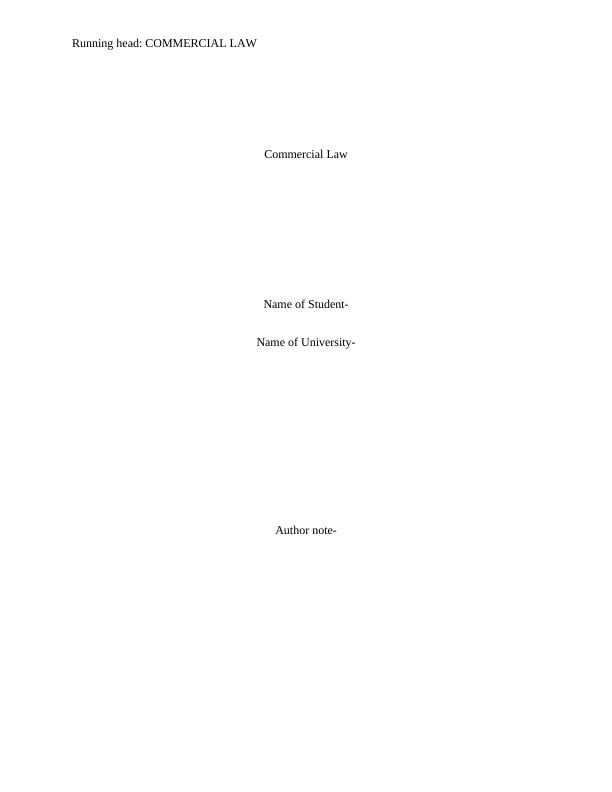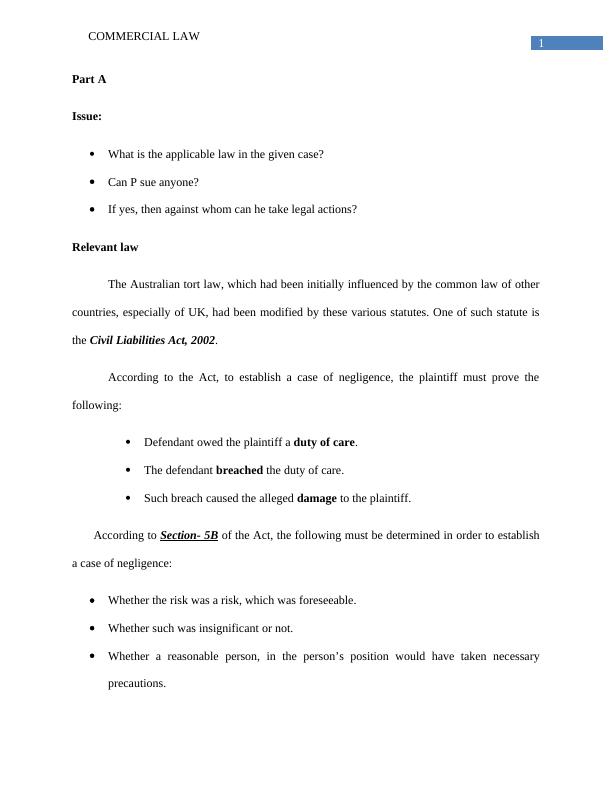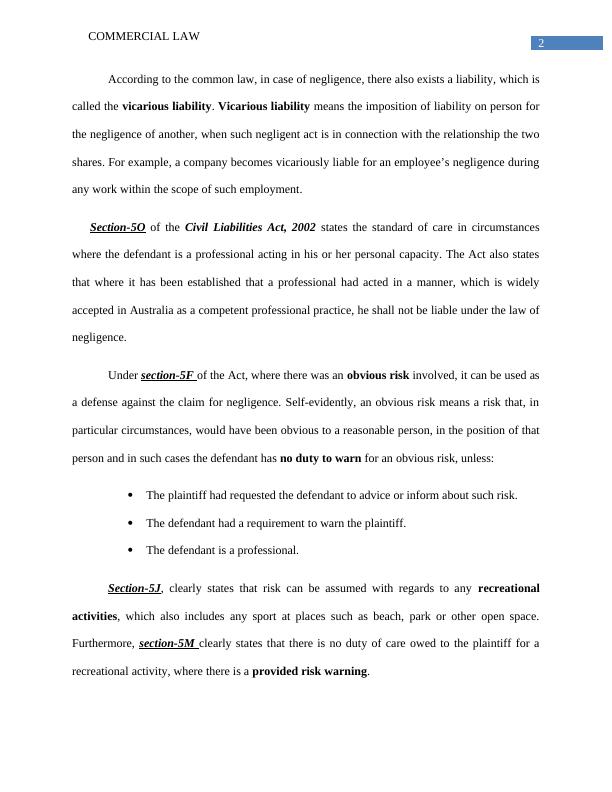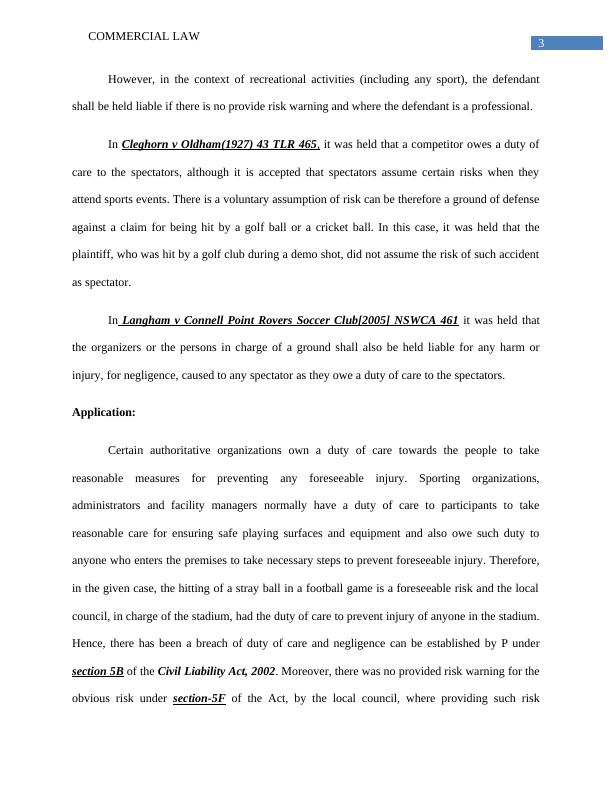Ask a question from expert
Commercial Law Assignment:Australian Tort Law
11 Pages2294 Words210 Views
Added on 2020-05-28
Commercial Law Assignment:Australian Tort Law
Added on 2020-05-28
BookmarkShareRelated Documents
Running head: COMMERCIAL LAWCommercial LawName of Student-Name of University-Author note-

1COMMERCIAL LAWPart AIssue:What is the applicable law in the given case?Can P sue anyone? If yes, then against whom can he take legal actions?Relevant lawThe Australian tort law, which had been initially influenced by the common law of othercountries, especially of UK, had been modified by these various statutes. One of such statute isthe Civil Liabilities Act, 2002. According to the Act, to establish a case of negligence, the plaintiff must prove thefollowing:Defendant owed the plaintiff a duty of care.The defendant breached the duty of care.Such breach caused the alleged damage to the plaintiff. According toSection- 5Bof the Act, the following must be determined in order to establisha case of negligence:Whether the risk was a risk, which was foreseeable.Whether such was insignificant or not.Whether a reasonable person, in the person’s position would have taken necessaryprecautions.

2COMMERCIAL LAWAccording to the common law, in case of negligence, there also exists a liability, which iscalled the vicarious liability. Vicarious liability means the imposition of liability on person forthe negligence of another, when such negligent act is in connection with the relationship the twoshares. For example, a company becomes vicariously liable for an employee’s negligence duringany work within the scope of such employment.Section-5Oof theCivil Liabilities Act, 2002states the standard of care in circumstanceswhere the defendant is a professional acting in his or her personal capacity. The Act also statesthat where it has been established that a professional had acted in a manner, which is widelyaccepted in Australia as a competent professional practice, he shall not be liable under the law ofnegligence. Under section-5F of the Act, where there was an obvious risk involved, it can be used asa defense against the claim for negligence. Self-evidently, an obvious risk means a risk that, inparticular circumstances, would have been obvious to a reasonable person, in the position of thatperson and in such cases the defendant has no duty to warn for an obvious risk, unless:The plaintiff had requested the defendant to advice or inform about such risk.The defendant had a requirement to warn the plaintiff.The defendant is a professional.Section-5J, clearly states that risk can be assumed with regards to any recreationalactivities, which also includes any sport at places such as beach, park or other open space.Furthermore, section-5M clearly states that there is no duty of care owed to the plaintiff for arecreational activity, where there is a provided risk warning.

3COMMERCIAL LAWHowever, in the context of recreational activities (including any sport), the defendantshall be held liable if there is no provide risk warning and where the defendant is a professional.In Cleghorn v Oldham(1927) 43 TLR 465,it was held that a competitor owes a duty ofcare to the spectators, although it is accepted that spectators assume certain risks when theyattend sports events. There is a voluntary assumption of risk can be therefore a ground of defenseagainst a claim for being hit by a golf ball or a cricket ball. In this case, it was held that theplaintiff, who was hit by a golf club during a demo shot, did not assume the risk of such accidentas spectator. In Langham v Connell Point Rovers Soccer Club[2005] NSWCA 461it was held thatthe organizers or the persons in charge of a ground shall also be held liable for any harm orinjury, for negligence, caused to any spectator as they owe a duty of care to the spectators.Application:Certain authoritative organizations own a duty of care towards the people to takereasonable measures for preventing any foreseeable injury. Sporting organizations,administrators and facility managers normally have a duty of care to participants to takereasonable care for ensuring safe playing surfaces and equipment and also owe such duty toanyone who enters the premises to take necessary steps to prevent foreseeable injury. Therefore,in the given case, the hitting of a stray ball in a football game is a foreseeable risk and the localcouncil, in charge of the stadium, had the duty of care to prevent injury of anyone in the stadium.Hence, there has been a breach of duty of care and negligence can be established by P undersection 5B of the Civil Liability Act, 2002. Moreover, there was no provided risk warning for theobvious risk under section-5F of the Act, by the local council, where providing such risk

End of preview
Want to access all the pages? Upload your documents or become a member.
Related Documents
Negligence and Negligent Misrepresentation in Commercial Lawlg...
|8
|2104
|456
Understanding Tort Law and Liability in Common Law Systemlg...
|5
|1518
|377
Claim Compensations From Financial Advisorlg...
|7
|1619
|23
Essentials of Negligence | Lawlg...
|7
|1174
|24
Assignment On Contract Law & Common Law - Breach Of RIghtslg...
|10
|3515
|141
Case Study about the Business Law 2022lg...
|7
|994
|16